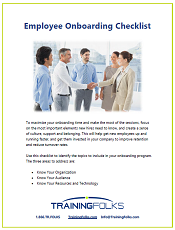ONBOARDING BEST PRACTICES FROM A TOP TRAINING COMPANY

Onboarding Best Practices: How to Decrease Your Employee Onboarding Time
When new hires show up at your company on their first day, eager to get started in their new position, how are they greeted? Do they spend most of the day doing paperwork, waiting for their computers and cellphones to be set up, given documents to read while their managers are busy in meetings? Or do you have a formal employee onboarding program that makes them feel welcome and reinforces the decision to join your company?
Studies show that a poor onboarding program can result in 20% of staff turnover within the first 45 days. Considering the amount of time and money spent on recruiting the top talent, can your company afford NOT to have an effective onboarding program?
Here are examples of companies with unique onboarding programs:
- An article in Fast Company titled “Why MailChimp Doesn’t Let New Hires Work for Their First Week on the Job” outlines the company’s week-long employee onboarding process. They are greeted with swag and a decorated desk, and spend the week learning about the company, meeting key team members from every department including the co-founders, and of course learning how to use the product. It seems this onboarding program is working – MailChimp’s turnover rate is only 4%.1
- Spredfast, an Austin-based social media marketing agency, starts new hires on Friday instead of Monday, which is typical of most companies. “[On Mondays] People are running around trying to get caught up from the weekend,” says Sam Baber, vice president of talent and development. “When you’re starting someone new at your company, you want an atmosphere with less chaos.”2
- At FreshBooks, a cloud-based accounting software company in Toronto, Canada, CEO Mike McDerment says that all new employees, no matter what level, spend their first month working in customer service. Delivering outstanding service is a core value that underlies everything the company does, and this month spent learning about the company through the eyes of its customers instills in employees the importance of service, that they, in turn, bring to their roles.
Some companies may think they “don’t have time” to implement a formal onboarding program. The truth is, a program can actually decrease the onboarding orientation time. When new hires are given the upfront company information they need that could take weeks or even months to learn organically, it can help them get up and running in their role much more quickly.
The question is, what are the most important topics to include in an effective onboarding program?
Find out more about our employee onboarding solutions.
To help you identify the key information to cover when onboarding new employees, download the Employee Onboarding Checklist. It outlines the areas such as the organization’s background, the needs of the audience and the available resources for conducting training, as well as a list of topics that can streamline your process. You can use this checklist to evaluate your current employee onboarding program or to develop a new program.
Even if you don't have the time or resources to make major changes now, this checklist provides ideas you can use to supplement your existing onboarding program to improve its effectiveness.
Also read:
How Effective is Your Employee Onboarding Process?
Bad Employee or Bad Onboarding?
Combat Employee Turnover with Employee Engagement
1 Why MailChimp Doesn’t Let New Hires Work for Their First Week on the Job
2 Why This Tech Company Starts New Hires On Fridays (And Why You Should, Too)

